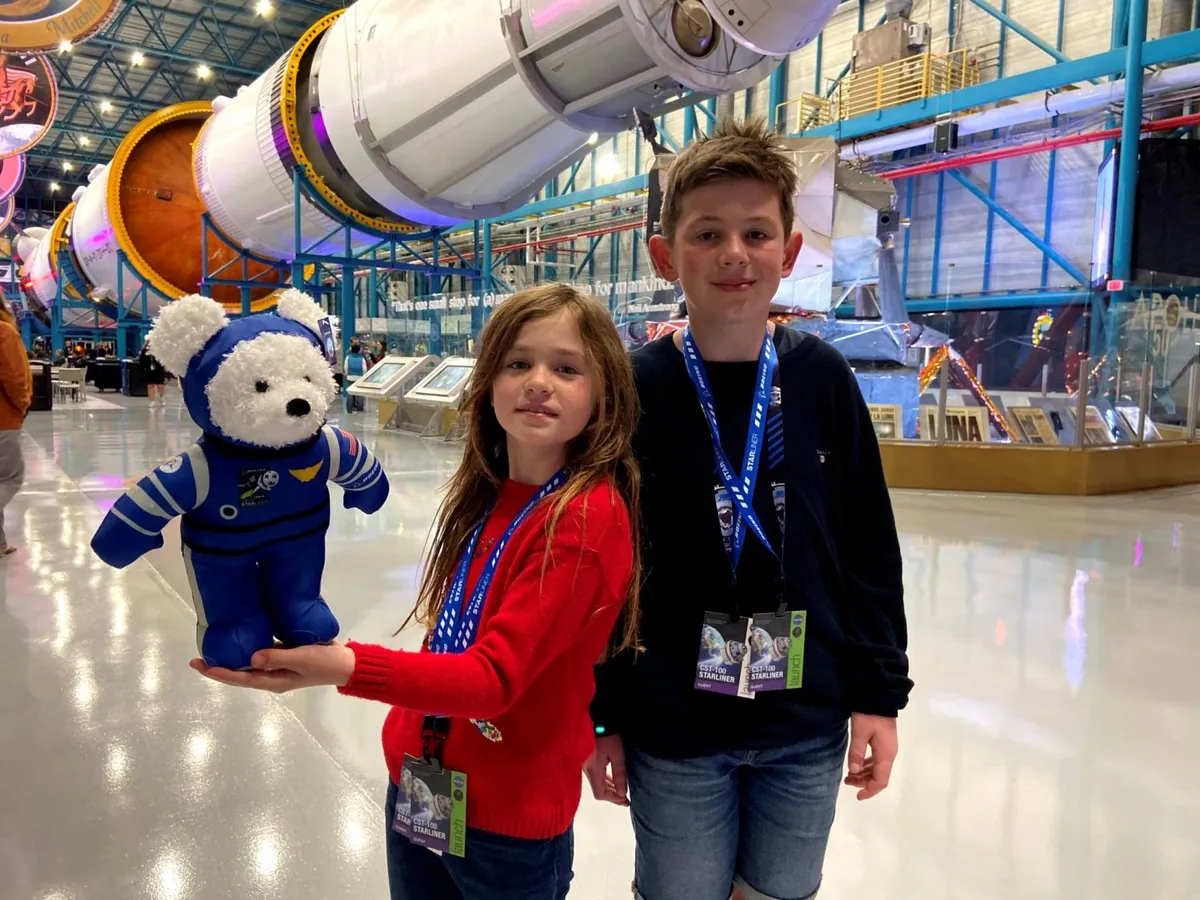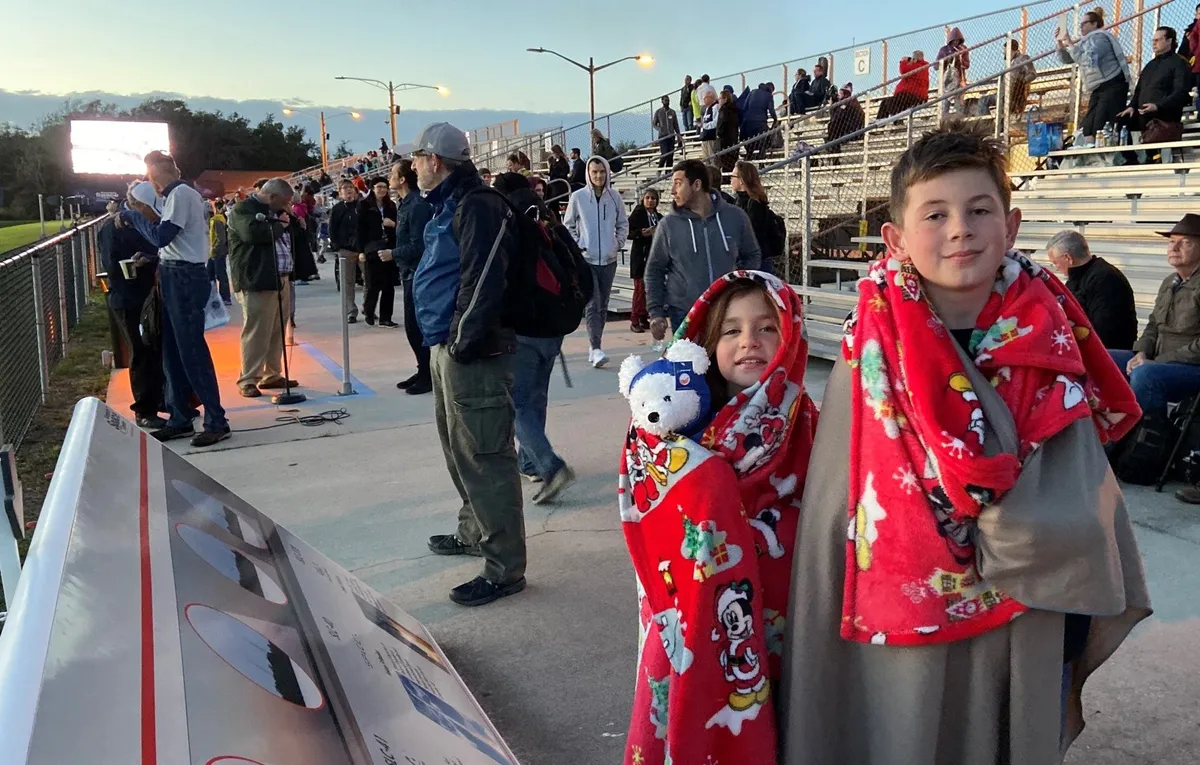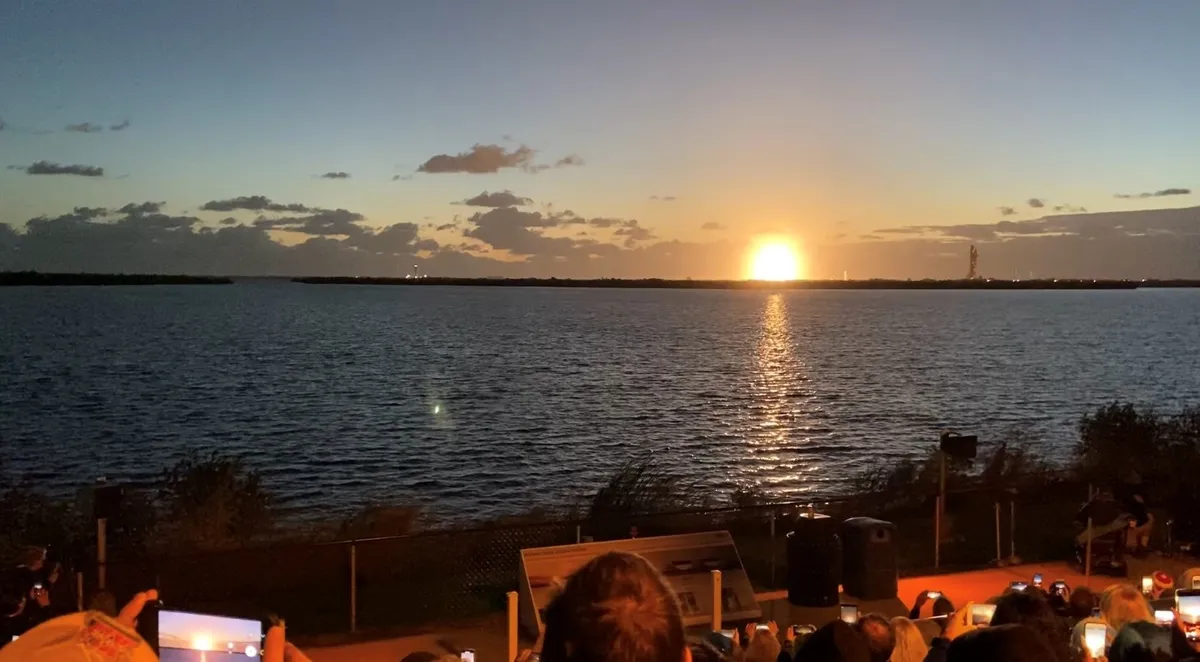It’s 3.30am and I’m waiting with my family in a church car park on the east coast of Florida. It’s 20 December. We’re sat in our car, watching the clock, waiting for 4am when we are due to register our arrival with NASA representatives. We’ve already (proudly) placed our ‘NASA Guest’ pass under the windscreen of our rental car. It’s cold by Florida standards, but warmer than a December night back home.
The sky is inky black and full of stars. We’re not alone in the car park: there are at least a dozen other cars. We’re all waiting to witness something really special, something that not many people will get to see.
Rewind 6 months to a slightly warmer summer evening in the UK when my Daughter Ciara (8), who is obsessed with space, said she would really like to see a space rocket launch.
That evening, together we wrote to NASA and didn’t really expect to receive a reply. A few days later an email landed. Incredibly, not only was this a reply from NASA, but even more astonishingly this email was from Robert Cabana, former astronaut and Space Shuttle Commander, now head of NASA at Kennedy Space Center.
Cabana explained how glad he was that Ciara shared his passion for science and space and how he would be pleased to help grow that passion.

Robert put us in touch with another NASA employee who would take care of us. My jaw hit the floor and Ciara screamed with excitement when I told her.
After exchanging a few emails with various NASA employees, we eventually received personal invitations to the maiden launch of Boeing’s CST-100 Starliner Spacecraft, the very first unmanned test flight.
As we were ‘foreign nationals’ we first had to be cleared by NASA security who wanted to know who we worked for, job titles, passport numbers etc.
It was all incredibly exciting for a regular family from Hampshire. We soon had flights booked and were counting down the days.
We arrived in Florida 8 days prior to the launch and received news that the launch had been postponed until 18 December. No problem...we spent a few days at Disney.
Then we received another email confirming a further delay: the launch would now be 20 Dec at 6.36am, just 2 days before our return flight to Gatwick. We crossed our fingers that it wouldn’t change again. Thankfully, it didn’t.
We collected our rental car the day before. The launch time meant a ridiculously early alarm call of 1.45am: just enough time for a few hours sleep.
Soon we would be speeding through the night, heading towards a church car park where we would register with NASA staff and board a bus to the launch site. It all felt slightly surreal.

Just before 4am people started getting out of their cars and some important looking people from NASA appeared.
Upon recognising our accent, they seemed immediately interested, noting that we were the 'foreign nationals' and explaining that we would need to collect special accreditation at the viewing site.
Shortly afterwards, a silver NASA bus pulled into view with that distinctive ‘meatball’ logo and at that very point, a wave of excitement rolled over me.
For a few seconds I felt as though we were the astronauts being collected to board the rocket, just like I’d seen Neil, Buzz and Michael do in that historic footage from 1969.
The bus journey took about 30 minutes as we travelled onto the Merritt Island nature reserve where NASA is based. It soon became apparent that our compatriots on the bus were all NASA employees or close family.
I couldn’t help but eavesdrop on a conversation between 2 passengers next to us as they discussed the science experiments they had been working on that were amongst the payload. We felt incredibly lucky to be on this very special bus.
We also learnt that amongst the payload were Christmas presents for the astronauts on the International Space Station, presumably from family members back on Earth who would be spending Christmas without them.
We explained to our children that Father Christmas would be so busy delivering presents on Earth he wouldn't get chance to visit the ISS: hence the precious cargo.
A couple of NASA employees were our 'hosts' and sat at the front of the bus, taking it in turns to speak to us over the PA system.
We were told that since the retirement of the Space Shuttle in 2011, NASA currently pay Russia £80m for a seat to the ISS.

It was clear that launching humans into space from Kennedy again was a matter of immense national pride, but also of genuine commercial importance.
Lanyards with 'Launch Guest' written on them were handed out on the bus, along with NASA branded gift bags containing stickers, a calendar and a 'squishy' blue Starliner astronaut toy that the kids (the only children on the bus) thought was great.
The NASA guy doing most of the talking over the microphone was awesome: a genuine space geek who’s responsible for some heavyweight IT projects within NASA.
He kept us entertained as we passed through into Kennedy Space Center. Suddenly the infamous Vehicle Assembly Building came into view: the building we all recognise from countless TV programmes.
This is where the massive Saturn V launch vehicles are assembled and as our host proudly pointed out, it’s also the biggest single storey building in the word.
I think it would be fair to say that at this point we were more than a little bit excited. We were then given a safety warning, making sure we understood we were present at our own risk and despite all reasonable precautions, NASA couldn’t guarantee that in the event of catastrophic failure, a piece of rocket might not come flying in our direction. Gulp.
It wasn’t long before the bus stopped at the viewing location. I hadn’t realised we would be viewing from just outside the Apollo/Saturn V centre!
What’s more, it turned out that this huge building that houses 1 of the 3 remaining Saturn V rockets was open at this ridiculously early time just for us and the other guests.

We still had plenty of time before the launch so we jumped off the bus to explore. The Saturn V rocket is simply enormous and dwarfs the other rockets on display at KSC.
Breakfast was laid on for us on tables set up alongside the Saturn V rocket, and we enjoyed a very welcome meal of breakfast patties, omelettes and fruit.
We finished breakfast and got our ‘souvenir photo’ taken in the green screen booth before heading back outside.
Bleacher seating had been laid on for us, looking towards the launch site. The Atlas V rocket was in the distance illuminated by powerful spotlights, clearly visible, but several miles away.
I guess this is an indication of the vast scale of the rocket with the relatively small Starliner capsule perched precariously on top.
It’s an exposed site and a cold wind blowed relentlessly over us. We were glad we packed blankets. A large screen had been set up showing close-up images of the rocket.
Helium and hydrogen gases could be seen billowing from bleeder valves to maintain safe pressures, and there was also a red LED countdown timer
We were seconds away from launch. We’d been told that it could be scrubbed at any time, so we kept our fingers crossed until the very last second.
With eyes absolutely glued to the tiny white rocket in the distance, we counted down with the crowd: 10...9...8...7...6...5...4...fingers still firmly crossed...3...2...1... "we are go for launch".
The rocket was no longer discernible, now replaced by a glowing ball of light, as bright as the rising Sun. It cast a beautiful light pattern over the cold water below as it moved up, towards the night sky.
The crowd were pretty much silent, aside from a few gasps and remarkably still no noise at all from the rocket.
The light grew brighter and slowly the rocket ship and the star liner spacecraft, with its payload of science experiments and Christmas presents, moved higher into the night sky on its way to the ISS.
The commentator warned us that in a few seconds the sound would hit us and began counting down from 10 seconds again. He didn’t actually get past '3' as the roar from the Atlas V rocket hit us, like a tsunami of noise to accompany the light show.
You first felt it through the ground, then through your chest. It was then I experienced an emotion that I hadn’t anticipated. It all felt suddenly ‘moving,’ spiritual almost, like an ancient Mayan tribe watching a lunar eclipse.
You couldn’t help but find yourself in absolute awe of the spectacle before you, like nothing you had ever seen before.
The rocket was now high in the sky and the billowing trail of vapour below, blown by that relentless December wind, suggested an erratic journey to the heavens, which couldn’t have been further from the truth.
We watched as the rockets separated and the light grew fainter. I’m not sure we said anything at all, any of us, we just stared, mouths open, soaking up every nano-second.
Then came confirmation that the rocket had broken the sound barrier, and then that it had entered the upper atmosphere.
It was now just a faint spec, blending with the thousands of other stars in the night sky. And then it was gone. I think it was then that I remembered to breath.
There were a few typically American ‘whoops’ and excited chatter as the magnitude of what we had all just witnessed started to sink in.
The launch pad, where just a few seconds ago sat a huge rocket, was now strikingly empty, having fulfilled its part of the mission.
The spaceship was now in orbit around the Earth. Moments like that are difficult to articulate.

Soon after we left the launch site and the NASA bus took us back to our rendezvous point. On the journey back, whilst quietly letting what we’d just witnessed sink in, our host pointed out a huge 8 ft. wide bald eagle nest on the right hand side that had been there for decades.
As we passed, I wondered if that is where NASA drew inspiration for the Eagle on the Apollo 11 flight patch.
Before disembarking the bus we thanked our hosts, who handed us complimentary tickets to the visitor centre.
The next few hours were spent taking in all that is on display at this incredible place. One of the unlikely highlights was the Astronaut Memorial, which is an incredibly moving tribute to those brave men and woman who gave their lives for the cause, including those from Challenger and Columbia disasters. Personally, I find the story of Christa McAuliffe particularly poignant.
It wasn’t long before we were on the flight home. Scrolling thought the movies on offer I couldn't resist clicking on First Man, about the life of Neil Armstrong, affording myself just a couple more hours of ‘space’ indulgence before arriving safely back in the UK with Conor and Ciara excited to share the incredible experience with their class.
Sadly, we learnt soon after arriving back home that the Starliner hadn’t made it to the ISS. A technical gremlin, which would have been easily correctable by a flight crew, had meant the spacecraft ended up in an orbit that was incompatible with a dock with the ISS.
Instead, after 3 days in Space, Starliner would return to Earth.
Which it did, landing successfully with parachutes and airbags in New Mexico. Failure to reach the ISS really shouldn’t detract from what is a remarkable achievement.
After all, that’s why it was a ‘test flight’, and to use the words of John F Kennedy, we do these things “not because they are easy, but because they are hard”.
If it was easy, I’d probably be building my own spaceship. Well done NASA and well done Boeing, we are forever grateful.